 |
|||||
| Home | Research | For Teachers | HISTORY Level 1 Level 2 Level 3 |
PRINCIPLES Level 1 Level 2 Level 3 |
CAREER Level 1 Level 2 Level 3 |
| Gallery | Hot Links | What's New! | |||
| Web Administration and Tools | |||||
 |
|||||
| Home | Research | For Teachers | HISTORY Level 1 Level 2 Level 3 |
PRINCIPLES Level 1 Level 2 Level 3 |
CAREER Level 1 Level 2 Level 3 |
| Gallery | Hot Links | What's New! | |||
| Web Administration and Tools | |||||
![]()
The first rockets ever built, the fire-arrows of the Chinese, were not very reliable. Many just exploded on launching. Others flew on erratic courses and landed in the wrong place. Being a rocketeer in the days of the fire-arrows must have been an exciting, but also a highly dangerous activity.
Today, rockets are much more reliable. They fly on precise courses and are capable of going fast enough to escape the gravitational pull of Earth. Modern rockets are also more efficient today because we have an understanding of the scientific principles behind rocketry. Our understanding has led us to develop a wide variety of advanced rocket hardware and devise new propellants that can be used for longer trips and more powerful takeoffs.
Most rockets today operate with either solid or liquid propellants. The word propellant does not mean simply fuel, as you might think; it means both fuel and oxidizer. The fuel is the chemical rockets burn but, for burning to take place, an oxidizer (oxygen) must be present. Jet engines draw oxygen into their engines from the surrounding air. Rockets do not have the luxury that jet planes have; they must carry oxygen with them into space, where there is no air.

Solid rocket propellants, which are dry to the touch, contain both the fuel and oxidizer combined together in the chemical itself. Usually the fuel is a mixture of hydrogen compounds and carbon and the oxidizer is made up of oxygen compounds. Liquid propellants, which are often gases that have been chilled until they turn into liquids, are kept in separate containers, one for the fuel and the other for the oxidizer. Then, when the engine fires, the fuel and oxidizer are mixed together in the engine.
| A solid-propellant rocket has the simplest form of engine. It has a
nozzle, a case, insulation, propellant, and an igniter. The case of the engine is usually
a relatively thin metal that is lined with insulation to keep the propellant from burning
through. The propellant itself is packed inside the insulation layer. Many solid-propellant rocket engines feature a hollow core that runs through the propellant. Rockets that do not have the hollow core must be ignited at the lower end of the propellants and burning proceeds gradually from one end of the rocket to the other. In all cases, only the surface of the propellant burns. However, to get higher thrust, the hollow core is used. This increases the surface of the propellants available for burning. The propellants burn from the inside out at a much higher rate, and the gases produced escape the engine at much higher speeds. This gives a greater thrust. Some propellant cores are star shaped to increase the burning surface even more. |
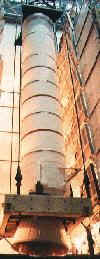 |
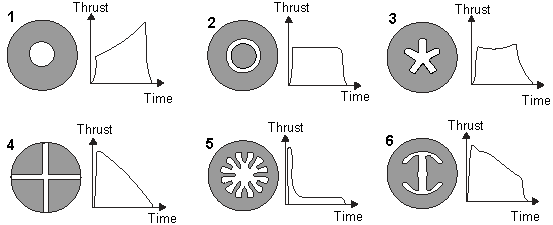
Solid Propellant Cross-Sections and Their Burntime Histories
To fire solid propellants, many kinds of igniters can be used. Fire-arrows were ignited by fuses, but sometimes these ignited too quickly and burned the rocketeer. A far safer and more reliable form of ignition used today is one that employs electricity. An example of an electrically fired rocket is the space shuttle's SRM (see picture below-right). An electric current, coming through wires from some distance away, heats up a special wire inside the rocket. The wire raises the temperature of the propellant it is in contact with to the combustion point.
Other igniters are more advanced than the hot wire device. Some are encased in a chemical that ignites first, which then ignites the propellants. Still other igniters, especially those for large rockets, are rocket engines themselves. The small engine inside the hollow core blasts a stream of flames and hot gas down from the top of the core and ignites the entire surface area of the propellants in a fraction of a second.
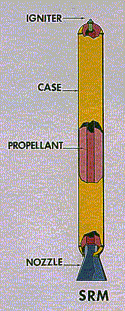 The nozzle in a solid-propellant engine
is an opening at the back of the rocket that permits the hot expanding gases to escape.
The narrow part of the nozzle is the throat. Just beyond the throat is the exit cone. The
purpose of the nozzle is to increase the acceleration of the gases as they leave the
rocket and thereby maximize the thrust. It does this by cutting down the opening through
which the gases can escape.
The nozzle in a solid-propellant engine
is an opening at the back of the rocket that permits the hot expanding gases to escape.
The narrow part of the nozzle is the throat. Just beyond the throat is the exit cone. The
purpose of the nozzle is to increase the acceleration of the gases as they leave the
rocket and thereby maximize the thrust. It does this by cutting down the opening through
which the gases can escape.
To see how this works, you can experiment with a garden hose that has a spray nozzle attachment. This kind of nozzle does not have an exit cone, but that does not matter in the experiment. The important point about the nozzle is that the size of the opening can be varied. Start with the opening at its widest point. Watch how far the water squirts and feel the thrust produced by the departing water. Now reduce the diameter of the opening, and again note the distance the water squirts and feel the thrust. Rocket nozzles work the same way.
As with the inside of the rocket case, insulation is needed to protect the nozzle from the hot gases. The usual insulation is one that gradually erodes as the gas passes through. Small pieces of the insulation get very hot and break away from the nozzle. As they are blown away, heat is carried away with them.
The other main kind of rocket engine is one that uses liquid propellants. This is a much more complicated engine, as is evidenced by the fact that solid rocket engines were used for at least seven hundred years before the first successful liquid engine was tested. Liquid propellants have separate storage tanks - one for the fuel and one for the oxidizer. They also have pumps, a combustion chamber, and a nozzle.
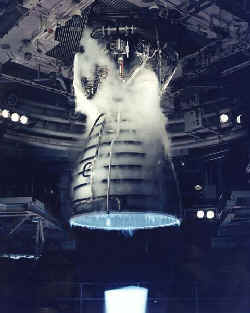
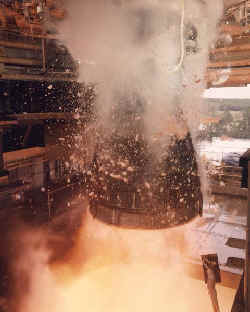
The fuel of a liquid-propellant rocket is usually kerosene or liquid hydrogen; the oxidizer is usually liquid oxygen. They are combined inside a cavity called the combustion chamber. P&W HIGH PRESSURE TURBOPUMPS provide an example of the rocket engine. Here the propellants burn and build up high temperatures and pressures, and the expanding gas escapes through the nozzle at the lower end. To get the most power from the propellants, they must be mixed as completely as possible. Small injectors (nozzles) on the roof of the chamber spray and mix the propellants at the same time. Because the chamber operates under high pressures, the propellants need to be forced inside. Powerful, lightweight turbine pumps between the propellant tanks and combustion chambers take care of this job.
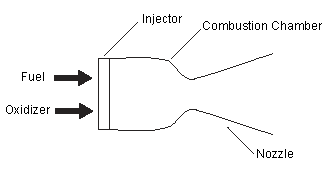
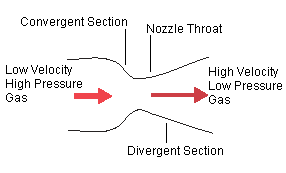
With any rocket, and especially with liquid-propellant rockets, weight is an important factor. In general, the heavier the rocket, the more the thrust needed to get it off the ground. Because of the pumps and fuel lines, liquid engines are much heavier than solid engines.
One especially good method of reducing the weight of liquid engines is to make the exit cone of the nozzle out of very lightweight metals. However, the extremely hot, fast-moving gases that pass through the cone would quickly melt thin metal. Therefore, a cooling system is needed. A highly effective though complex cooling system that is used with some liquid engines takes advantage of the low temperature of liquid hydrogen. Hydrogen becomes a liquid when it is chilled to -253o C. Before injecting the hydrogen into the combustion chamber, it is first circulated through small tubes that lace the walls of the exit cone (look at the 5 main engines of the Saturn shown below-right, or the engine being test fired below-right). In a cutaway view, the exit cone wall looks like the edge of corrugated cardboard. The hydrogen in the tubes absorbs the excess heat entering the cone walls and prevents it from melting the walls away. It also makes the hydrogen more energetic because of the heat it picks up. We call this kind of cooling system regenerative cooling.

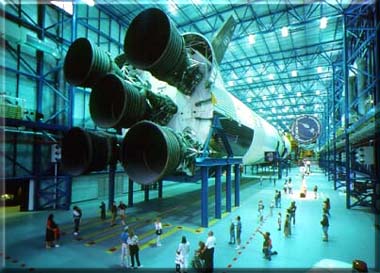
TO THE EXHAUST GASES' DIAMOND PATTERN PAGE - SECTION 3
Send all comments to ![]() aeromaster@eng.fiu.edu
aeromaster@eng.fiu.edu
© 1995-98 ALLSTAR Network. All rights reserved worldwide.
Updated: February 23, 1999